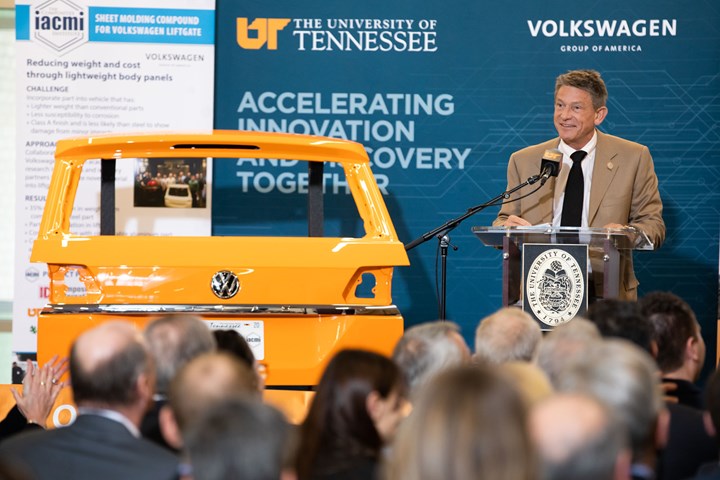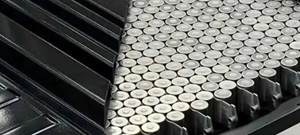Volkswagen, ORNL, UT collaborate on innovation hub
Initial work at Volkswagen’s first North American innovation hub will focus on developing composite vehicle components and electrification of vehicles.

IACMI’s Sean Lee and Tessa Patton work on the composite liftgate created for Volkswagen in their lab at SERF (Science Engineering Research Facility) on the campus of UT Knoxville. Source | University of Tennessee, photo by Sam Thomas
On Jan. 17, Volkswagen Group of America (Herndon, Va., U.S.), a member of the Institute for Advanced Composites Manufacturing Innovation (IACMI; Knoxville, Tenn., U.S.), announced that it is collaborating with Oak Ridge National Laboratory (ORNL; Knoxville) and the University of Tennessee (UT; Knoxville) to create Volkswagen’s first innovation hub in North America at the UT Research Park in Knoxville.
The collaboration involves research opportunities for doctoral students and space in the Innovation North building at the UT Research Park at Cherokee Farm in Knoxville. Initial work will focus on developing lighter vehicle components made from composite materials and the electrification of vehicles.
Volkswagen has been a partner of the University of Tennessee since opening its Chattanooga Assembly plant in 2011. The Chattanooga facility assembles the Volkswagen Passat sedan and Atlas and Atlas Cross Sport SUVs, specifically designed for the North American market. In the fall of 2019, Volkswagen of America broke ground on a new electric vehicle production facility, which includes a 564,000-square-foot body shop addition and up to 1,000 new jobs in Tennessee.
In addition, UT Chattanooga and Volkswagen have developed an MBA program allowing Volkswagen employees to earn the degree by taking classes at the plant or on campus. Volkswagen also is a member of IACMI, managed by Collaborative Composite Solutions, a not-for-profit organization established by the UT Research Foundation. IACMI is supported by the U.S. Department of Energy’s Advanced Manufacturing Office, and has supported UT researchers, Volkswagen engineers and their collaborators in the creation of a novel composite liftgate for the Volkswagen Atlas that reduces weight by 35% as well as reducing investment cost.

UT Interim President Randy Boyd. Source | University of Tennessee
The new innovation hub in Knoxville will join Volkswagen’s larger global innovation ecosystem. This includes innovation centers in Belmont, Calif., U.S.; Wolfsburg, Germany; and Beijing, China along with innovation hubs in Barcelona, Spain; Tel Aviv, Israel; and Tokyo, Japan.
“Working with the University of Tennessee and Oak Ridge National Laboratory is a great opportunity to continue growing Volkswagen’s engineering footprint in the North American region,” says Wolfgang Demmelbauer-Ebner, executive vice president and chief engineering officer for Volkswagen’s North American region. “This hub, along with other research institutions here, is an integral part of Volkswagen’s global research and development efforts and can also directly contribute to vehicles in North America.”
“The partnership between UT, Oak Ridge National Laboratory and Volkswagen strengthens Tennessee’s position as a significant source of innovation and talent for the Volkswagen’s North American manufacturing base, especially at the flagship Chattanooga facility,” says Randy Boyd, UT interim president. “These types of partnerships are transforming the Tennessee Valley Corridor into a global innovation leader.”
“By identifying difficult challenges and pursuing creative solutions with immediate industrial application, we can accelerate fields such as materials science, energy storage and advanced manufacturing while making vehicles better, safer and more fuel efficient,” says Thomas Zacharia, ORNL director.
“The innovations stemming from the IACMI partnership with Volkswagen have a direct and immediate impact on vehicle design and manufacturing right here in Tennessee,” UT Knoxville Chancellor Donde Plowman said. “These collaborative discoveries demonstrate the real-world potential of public-private partnerships.”
Related Content
The new Slate truck costs less than $20,000, uses PP composite body panels
Stylish vehicle EV pickup model is supported by a simplified manufacturing process. It is also capable of customization from two seats to five seats.
Read MoreComposites end markets: Batteries and fuel cells (2024)
As the number of battery and fuel cell electric vehicles (EVs) grows, so do the opportunities for composites in battery enclosures and components for fuel cells.
Read MoreEnvalior offers novel Tepex composite for EV battery housings
Low-thickness, recyclable thermoplastic composite passes strict thermal runaway tests for EV battery housings.
Read MoreMoving toward sustainable automotive parts manufacturing
How can the automotive supply chain prepare for future sustainability requirements? Tier 1 Kautex Textron discusses emissions reduction, design for circularity and transition to recycled/bio-based plastics.
Read MoreRead Next
VIDEO: High-volume processing for fiberglass components
Cannon Ergos, a company specializing in high-ton presses and equipment for composites fabrication and plastics processing, displayed automotive and industrial components at CAMX 2024.
Read MoreAll-recycled, needle-punched nonwoven CFRP slashes carbon footprint of Formula 2 seat
Dallara and Tenowo collaborate to produce a race-ready Formula 2 seat using recycled carbon fiber, reducing CO2 emissions by 97.5% compared to virgin materials.
Read MoreAssembling the Multifunctional Fuselage Demonstrator: The final welds
Building the all-thermoplastic composite fuselage demonstrator comes to an end with continuous ultrasonic welding of the RH longitudinal fuselage joint and resistance welding for coupling of the fuselage frames across the upper and lower halves.
Read More.jpg;width=70;height=70;mode=crop)













